Adrian Vidal/iStock via Getty Images
There were many great suggestions leading up to week 70, and making the decision about which position/s would be added wasn’t an easy task. For those of you who are new to this series, I dedicate my allocations every 10th week to the positions suggested by the readers. Week 70 was the 7th time I have done this, and I chose to add Corning Incorporated (GLW) and the Amplify CWP Enhanced Dividend Income ETF (DIVO). Please keep suggesting new investments for this portfolio as I add them to a dedicated watchlist, and maybe your suggestion will get added in week 80 or 90.
The negative portfolio balance wasn’t eradicated in week 70, and the Dividend Harvesting portfolio has now finished in the red for 3 consecutive weeks. This portfolio finished -$208.41 and is in the red by -2.98%. The Dividend Harvesting portfolio has now finished in the red for the 5th time bringing its weekly success rate down to 92.86%. Investing isn’t always easy, and I believe it’s important to highlight these negative weeks. I don’t want anyone to get the idea that dividend investing will completely avoid periods of negativity. On the bright side, this portfolio was in the red by -$467.42 (-7.38%) at the end of week 68, so it’s slowly getting back to even.
As a long-term investor, these periods of weakness are exciting because I am able to add more to my investments at lower valuations. I actually look forward to the start of each week now because there are certain companies I want to add as I believe they are tremendously undervalued. Two of the names I believe are opportunities within the Dividend Harvesting portfolio are Citigroup (C) and Intel (INTC).
The Dividend Harvesting portfolio now has 76 positions and is generating a projected $491.43 in annual dividend income, which is a forward yield of 7.24%. I do not mind that the portfolio has dipped into the red over the past several weeks, as it’s allowing me to add to the portfolio from new allocated capital and dividend reinvestments at lower valuations. I am building out a personalized ETF that has proven to mitigate the downside throughout 2022. I plan to continue this practice for decades, and I believe the Dividend Harvesting portfolio will once again be in the black sooner rather than later.
I allocate capital toward big tech, funds, dividends, and growth outside of my retirement accounts. These are not my only investments, but I did open a separate account, so I could easily track and document this series. I intentionally created broad diversification throughout the Dividend Harvesting portfolio so I could benefit from sector rotations and mitigate my downside risk. Investors who are too exposed to growth companies or large-cap tech have gotten crushed as the investment landscape changes. On the growth and tech side of my investments, I am feeling the pain as some of my favorite companies, including Alphabet (GOOGL) (GOOG), Amazon (AMZN), and Meta Platforms (META), have been taken to the woodshed.
This series has never been about hitting a target yield, generating a certain amount of profit, or beating the market. I had two specific goals with this series. The first was to create a blueprint for constructing a dividend portfolio by documenting the journey starting from the beginning. The second goal was to illustrate how allocating capital each week toward investing, regardless of the amount, would be beneficial in the long run.
Too many people are under the illusion that you need tens of thousands or even hundreds of thousands to benefit from investing. Instead of using my real dividend portfolio as an example, I decided to start a new account, fund it with $100, and add $100 weekly, providing a step-by-step guide to dividend investing. This methodology doesn’t have to be used for dividend investing, and it could be as simple as an S&P index fund or a Total Market fund. Hopefully, this series is inspiring people to invest in their future to attain financial freedom.
A Historical recap of the Dividend Harvesting portfolio’s investment principles and historical performance
Below are the fundamental rules I have put in place for this portfolio:
- Allocate $100 weekly to this portfolio
- Only invest in dividend-producing investments
- No position can exceed 5% of the portfolio
- No sector can exceed 20% of the portfolio
- All dividends & distributions are to be reinvested
Below is a chart that extends from week 1 thru the current week to illustrate the Dividend Harvesting Portfolio’s Progression
- Blue line is my initial investment $100 in week 1, $1000 in week 10, etc.
- Red line is the account value at the end of each week
- Yellow line is the annual dividend income the Dividend Harvesting Portfolio was projected to generate after that week’s investments and dividends reinvested
The Dividend Harvesting Portfolio Dividend Section
Here is how much dividend income is generated per investment basket:
- Equities $157.5 (32.05%)
- ETFs $111.90 (22.77%)
- REITs $97.84 (19.91%)
- CEFs $92.87 (18.90%)
- BDC $25.94 (5.28%)
- ETNs $5.38 (1.09%)
Steven Fiorillo Steven Fiorillo 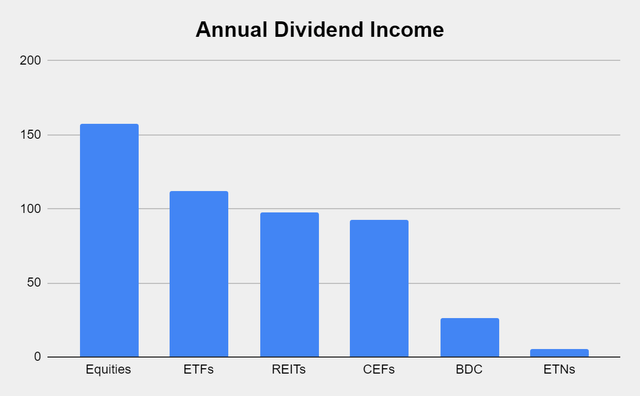
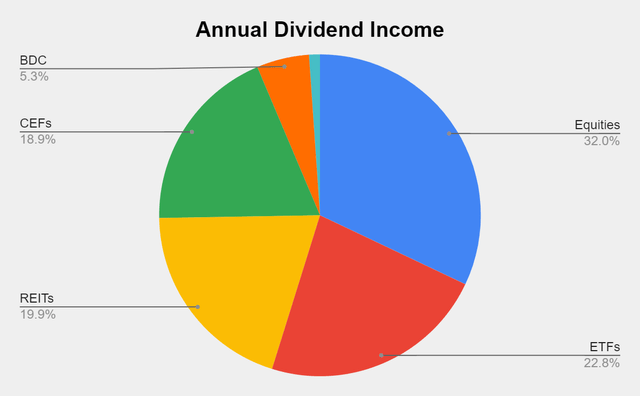
Collecting dividends can serve many functions in a portfolio. Some investors utilize dividends to supplement their income and live off. I am building a dividend portfolio for myself 30 years into the future. Since I am reinvesting every dividend, they serve multiple purposes today. In 2022 alone, I have collected $199.22 in dividend income from 260 dividends across 26 weeks. This has allowed the Dividend Harvesting portfolio to stay in the black while growing the snowball effect.
These dividends allow me to gain additional equity in my investments while increasing my future cash flow in down markets. This style of investing isn’t for everyone, but if you’re looking to generate consistent cash flow while mitigating downside risk, this method has worked for me. I am hoping to collect between $450-$500 in dividends in 2022, which will be reinvested, and finish the year generating >$700 in annual dividends.
The never-ending stream of dividend income just got a bit longer. There are now 564 annual dividends being produced after my additions of GLW and DIVO in week 70. Dividend income is being produced every week, and I think 600 annual dividends will be hit before labor day. It’s going to be very interesting to see what these numbers look like several years from now.
The goal of generating enough income from the dividends to purchase an additional share per year has been the never-ending project of this portfolio. There are now 5 positions that are generating at least 1 share annually through their dividends, which include Starwood Property Trust (STWD), PIMCO Corporate & Income Opportunity Fund (PTY), Broadmark Realty Capital (BRMK), AGNC Investment Corp. (AGNC), the Global X Russell 2000 Covered Call ETF (RYLD), and the Global X NASDAQ 100 Covered Call ETF (QYLD). I am trying to get more of the current positions over the finish line. Eventually, more positions will generate one share per year in dividend income.
|
Shares from Dividends Annually |
||||||||||
|
0-9.9% |
10-19.99% |
20-29.99% |
30-39.99% |
40-49.99% |
50-59.99% |
60-69.99% |
70-79.99% |
80-89.99% |
90-100% |
Generating > 1 share |
|
LGI |
FOF |
NYCB |
PFFA |
ALTY |
T |
USA |
PDI |
OHI |
QYLD |
|
|
BBDC |
C |
INTC |
MO |
BST |
BCAT |
ARCC |
ECC |
PTY |
||
|
BP |
MLPX |
KMI |
SLVO |
EXG |
GLDI |
THW |
BRMK |
|||
|
AMLP |
XYLD |
PFFD |
GSBD |
MPW |
RYLD |
|||||
|
KHC |
AQN |
NUSI |
ORCC |
AGNC |
||||||
|
JEPI |
QYLG |
UTF |
VZ |
STWD |
||||||
|
CWEN |
BDJ |
BTI |
||||||||
|
UTG |
SPG |
NRZ |
||||||||
|
SO |
ENB |
MFC |
||||||||
|
RQI |
XOM |
|||||||||
|
THQ |
AMZA |
|||||||||
|
OKE |
CCAP |
|||||||||
|
XYLG |
CSCO |
|||||||||
|
AY |
DIVO |
|||||||||
|
STAG |
||||||||||
|
VICI |
||||||||||
|
MMM |
||||||||||
|
O |
||||||||||
|
ORI |
||||||||||
|
MAIN |
||||||||||
|
ABBV |
||||||||||
|
ED |
||||||||||
|
GLW |
||||||||||
|
HPQ |
||||||||||
|
BMY |
||||||||||
|
KO |
||||||||||
|
BAC |
||||||||||
The Dividend Harvesting Portfolio composition
REITs and ETFs continue to flip flop between the top two spots. Only 0.36% separates these two sectors within the Dividend Harvesting portfolio. Individual equities make up 48.03% of the portfolio and generate 32.22% of the dividend income, while ETFs, CEFs, REITs, BDCs, and ETNs represent 51.97% of the portfolio and generate 67.68% of the dividend income. I have a 20% maximum sector weight, so when a singular sector gets close to that level, I make sure capital is allocated away from that area to balance things out. In 2022, I will make an effort to even out these portfolio percentages. As more capital is deployed, the bottom half of the portfolio weighting will increase.
|
Industry |
Investment |
Portfolio Total |
% of Portfolio |
|
REIT |
$1,137.94 |
$6,791.59 |
16.76% |
|
ETFs |
$1,113.96 |
$6,791.59 |
16.40% |
|
Closed End Funds |
$949.92 |
$6,791.59 |
13.99% |
|
Oil, Gas & Consumable Fuels |
$557.65 |
$6,791.59 |
8.21% |
|
Communication Services |
$543.62 |
$6,791.59 |
8.00% |
|
Consumer Staples |
$466.67 |
$6,791.59 |
6.87% |
|
Financials |
$428.18 |
$6,791.59 |
6.30% |
|
Technology |
$317.92 |
$6,791.59 |
4.68% |
|
BDC |
$299.17 |
$6,791.59 |
4.40% |
|
Utility |
$296.31 |
$6,791.59 |
4.36% |
|
Pharmaceuticals |
$234.71 |
$6,791.59 |
3.46% |
|
Industrials |
$131.19 |
$6,791.59 |
1.93% |
|
Independent Power & Renewable Electricity Producers |
$110.77 |
$6,791.59 |
1.63% |
|
ETN |
$39.43 |
$6,791.59 |
0.58% |
|
Cash |
$2.82 |
$6,791.59 |
0.04% |
Exxon Mobil (XOM) has overtaken INTC to move back into the top 3 largest positions in the Dividend Harvesting series. I am keeping an eye on Verizon as it’s getting close to my 5% cap for an individual position.
I was asked a question about if I would trim a position if, for some reason, it caught a bid and appreciated unexpectedly. I thought I would add my comment to the series. Hypothetically if VZ went to $70, it would certainly represent more than 5% of the portfolio next week. I wouldn’t sell a single share. The reason is that I am still allocating capital weekly, and the new capital would dilute its percentage of the portfolio over time. If this was a much larger portfolio that I wasn’t adding to, my answer would be different, and I would probably trim a bit.
This doesn’t mean that I wouldn’t take profits on positions in the portfolio, and I have considered selling XOM in the future. XOM has caught fire, and I am slightly worried about this administration. While I believe XOM is a great long-term hold, this could turn into a situation where I sell in the future and reestablish a position if it sells off. I really need to watch XOM and see what happens.
|
Week 70 Top 10 By % |
|
|
VZ |
4.64% |
|
OHI |
4.07% |
|
XOM |
4.06% |
|
INTC |
3.79% |
|
STWD |
3.61% |
|
T |
3.36% |
|
QYLD |
3.06% |
|
SPG |
2.84% |
|
C |
2.79% |
|
MO |
2.69% |
Week 70 Additions: Reader Suggestion week
Every 10th week I utilize my allocated capital to invest in positions suggested by the readers of this article. The readers are responsible for some great suggestions, and I am especially happy with the ones from this week. In week 70 I added:
Corning Incorporated
I honestly forgot about GLW as it had fallen off my radar. GLW has become a dividend powerhouse over the years, providing investors with 11 consecutive years of dividend growth. GLW pays a $1.08 dividend per share which is a forward yield of 3.38%. Its payout ratio is 45.62% which indicates that future years of dividend growth will be on the horizon.
I looked at GLW’s financials, and I am quite happy with what I found. Revenue has been growing YoY since 2016, and their operating income has been trending upward as well. GLW has a good balance sheet with just over $2 billion in cash on the books with less than $7 billion in long-term debt. GLW is generating $1.49 billion in FCF and trades at 17.84x its FCF as its market cap is $26.61 billion. I think paying 20x or less is a great deal for a company’s FCF, so I am very happy with this valuation.
Amplify CWP Enhanced Dividend Income ETF
DIVO just became one of my favorite ETFs, and I didn’t know about it until the other week. I wrote a dedicated article on DIVO, which can be read here. DIVO takes a tactical approach to utilizing a Covered-Call strategy in this Covered-Call ETF. Instead of writing Covered-Calls on an index, DIVO’s managers write Covered-Calls on individual positions. DIVO has two investment objectives first, to generate income, and second to provide capital appreciation to its investors. DIVO invests at least 80% of its net assets in dividend-paying securities trading on U.S based exchanges. You will only find what many would consider blue-chip companies as the fund portfolio is geared toward large-capitalization companies from the S&P 500, which are likely to sustain earnings, cash flow growth, and increase their dividends.
I like the mechanics because DIVO utilizes two methods to generate income, harvesting dividends and writing covered calls on its positions. The managers look to generate 2-3% of their gross income from harvesting dividends from their equity positions and another 2-4% from a Covered-Call strategy to generate options premiums. DIVO pays a $1.77 per share dividend, which is a forward yield of 4.84%, and its distributed monthly.
Week 71 Gameplan
I am leaning toward adding 1 share of INTC, 1 share of C, and another new position to the Dividend Harvesting portfolio. I stumbled upon the CBRE Global Real Estate Income Fund (IGR), and there is a good possibility it will become position #75 in the Dividend Harvesting portfolio.
Conclusion
The Dividend Harvesting portfolio finished in the red again, and my weekly percentage of staying profitable has declined to 92.86%. I am very happy with the progression of the Dividend Harvesting portfolio as it’s only down -2.98% and generating a 7.24% yield across 74 positions. I am quickly approaching $500 in my projected annual dividend income. I believe there are many opportunities in the market for income investors, and I am looking forward to adding to this portfolio during the market’s volatility.


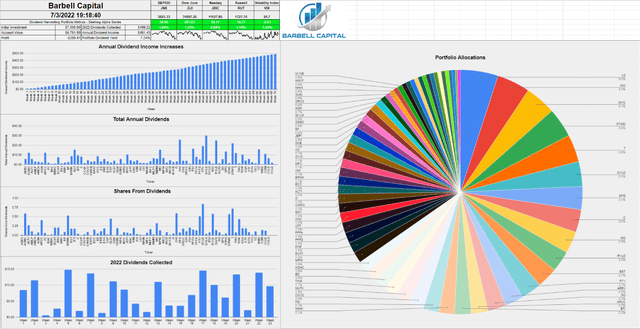
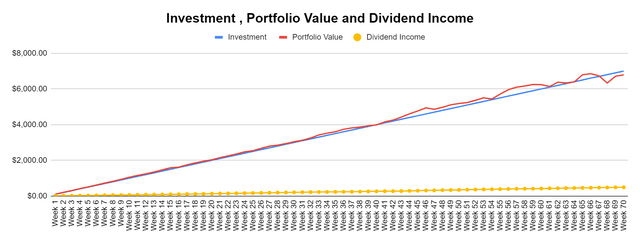
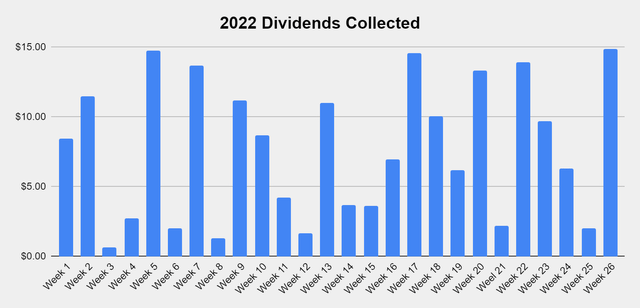

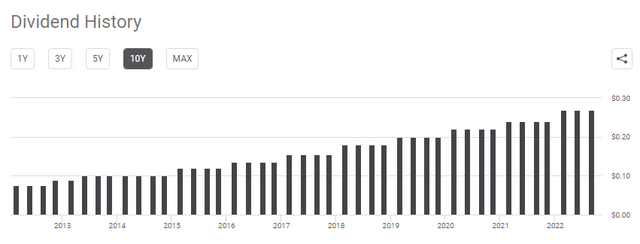
Be the first to comment